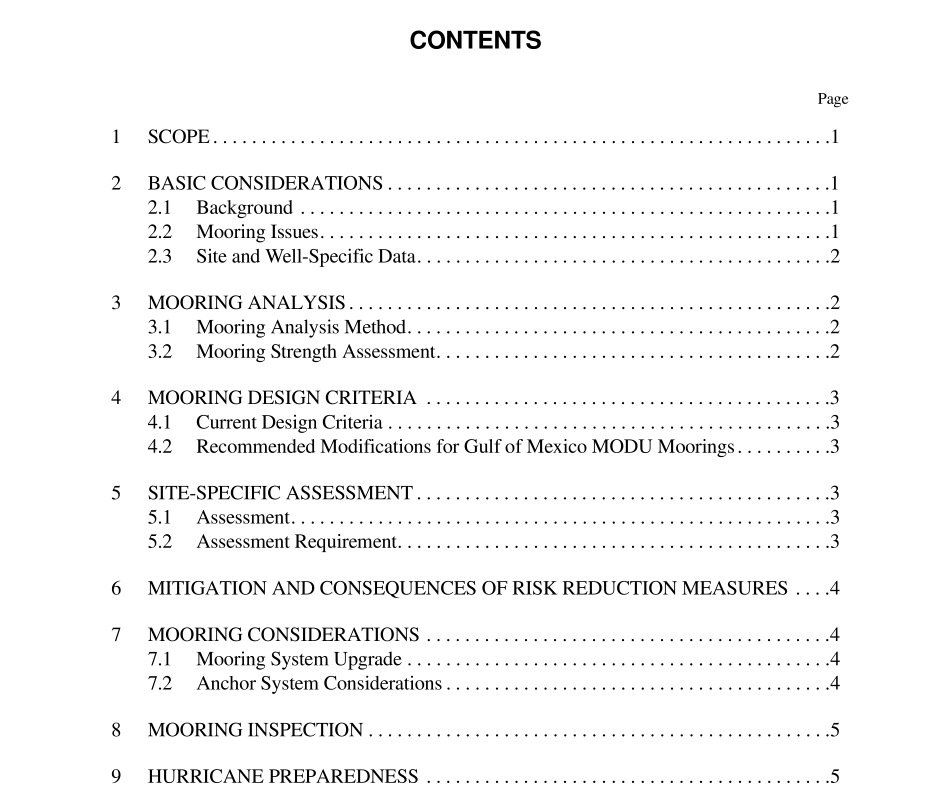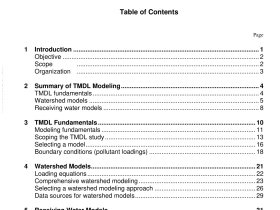API RP 95F pdf download

API RP 95F pdf download.Interim Guidance for Gulf of Mexico MODU Mooring Practice— 2006 Hurricane Season
1 Scope
This document provides guidance and processes and, when combined with an understanding of the environment at a particular location, the characteristics of the unit being utilized, and other factors, may be used to enhance operational integrity in the sur- vival condition. This guidance was developed through a cooperative arrangement with the American Petroleum Institute’s Sub- committee on Offshore Structures RP 2SK Task Group, the International Association of Drilling Contractors (IADC) Offshore Operations Division, and the Joint Industry Project entitiled “US Gulf of Mexico Mooring Strength Reliabilty” (MODU JIP). The information presented herein is premised on the existence of a MODU evacuation plan, the intent of which is to assure timely and safe evacuation of all MODU personnel in anticipation of hurricane conditions. This guidance is of an interim nature and is supplemental to the existing API RP 2SK, “Design and Analysis of Stationkeeping Systems for Floating Structures,” 3rd Edition (2005). This guidance also addresses documentation expectations.
2 Basic Considerations
2.1 BACKGROUND In 2004 and 2005, Hurricanes Ivan, Katrina, and Rita moved through the Gulf of Mexico with extreme wind and waves, causing a number of MODU mooring failures in their path. Mooring failures have occurred in previous hurricanes, including Hurricanes Andrew and Lili, but the number has been much lower. Assessment of MODU mooring systems for worldwide operations has frequently been based on API Recommended Practices. The first MODU mooring recommended practice, released in 1987, specified a design environment lower than the 5-10 year return period in the present version of API RP 2SK, principally driven by the MODU mooring capacities available at that time. Building on the results of a Joint Industry Project focused on MODU mooring code calibration (Noble Denton, 1995), API RP 2SK incorporated more severe MODU metocean design criteria. These criteria, which are still in the current version of API RP2SK, are as follows: • 5-year return period (away from other structure) • 10-year return period (next to other structure) There have been significant modifications in the underlying calibration parameters and Gulf of Mexico operations since the 1995 mooring code calibration study conducted 10 years ago which may influence the applicability to future activities. Differences include: 1. There are more floating and subsea installations and pipelines, which may result in higher risk of property damage or envi- ronmental impact, should a MODU break loose or drag its anchors under hurricane conditions. 2. The deepwater permanent installations have increased significantly, and therefore the cost for an incident can be much higher. These are high production rate installations that often share a pipeline to shore. 3. There are more deepwater MODU operations that typically use taut leg moorings with pile anchors, which may respond to hurricanes differently than the catenary moorings with drag anchors in shallow water operations.
3 Mooring Analysis
3.1 MOORING ANALYSIS METHOD
Following API RP 2SK, both quasi-static and dynamic analyses may be utilized for MODU moorings. Either 1-minute wind speed or 1-hour wind speed with wind spectrum may be used for wind force calculation. It should be noted that the wind spec- trum approach requires good estimates of low-frequency damping. Wind, wave, and current forces and vessel motions should be evaluated using up-to-date MODU information. Many MODUs have gone through significant modifications involving additional hull structures and deck equipment that can change the environ- mental loads on the vessel. Wind, wave, and current force coefficients and models for hydrodynamic analysis should be adjusted to reflect the changes. The adjustment can be based on performance parameters derived from new model tests or rigorous analy- sis. It is not possible to predict wind, wave, and current directions under hurricane conditions; therefore, sufficient environmental directions shall be investigated. As a minimum, bow, beam, quarter, down-line, and between-line environmental direction should be analyzed. Analysis for the damaged condition should investigate as many conditions as necessary to capture the critical case and as a minimum: damage of the most highly loaded line and adjacent lines.









